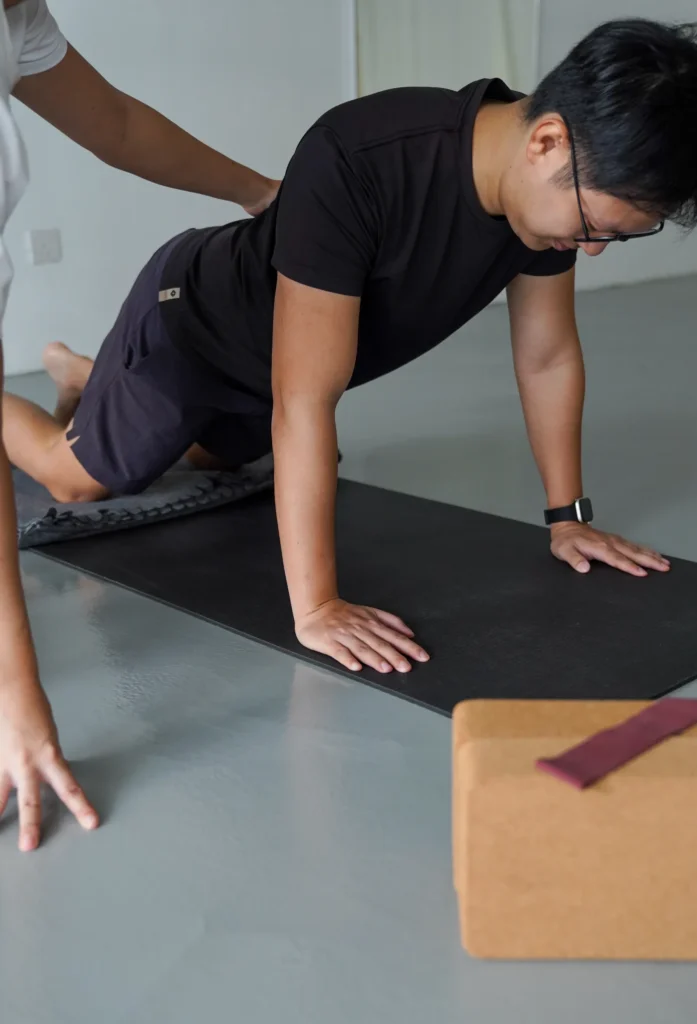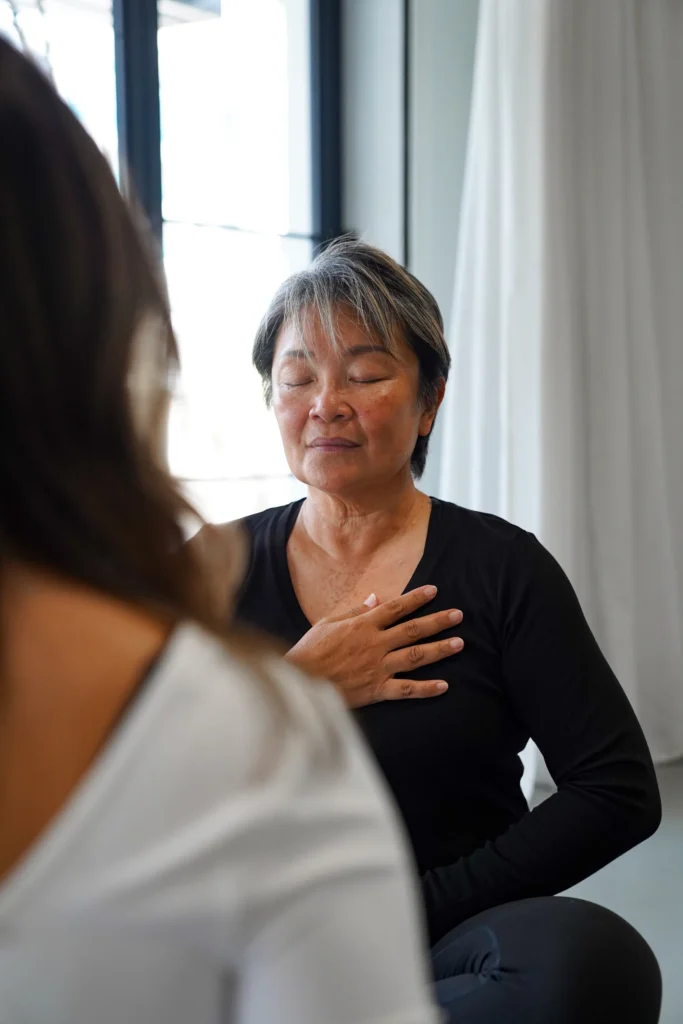Increasingly medical healthcare providers are prescribing Yoga as a healing movement modality to their patients. This ancient practice not only nurtures the physical body but also establishes a profound connection between the mind and body, unraveling the potential for transformative healing. This comprehensive guide delves into the multifaceted role of yoga in injury recovery, providing insights, techniques, and expert advice to empower your movement rehabilitation journey.
Understanding the Role of Yoga in Injury Recovery
The Mind-Body Connection: Yoga’s Impact on Healing
Yoga transcends the boundaries of physical exercise; it is a practice that marries movement with mindfulness. By integrating breath, movement, and awareness, yoga becomes a catalyst for the body’s innate capacity to heal. The synchronisation of these elements fosters a powerful mind-body connection, creating a fertile ground for recovery.
The Science Behind Yoga and Healing
How Yoga Affects the Nervous System
At the core of yoga’s healing prowess lies its profound influence on the nervous system. Through the different postures, breathing exercises and meditations, yoga intricately impacts the autonomic nervous system, modulating responses that range from heightened alertness to deep relaxation.
Regulation of Stress Responses
Stress is how the body responds to challenges. Through meditations, breathing exercises and postures, Yoga equips individuals with the tools to mindfully navigate stressful moments with grace.
Stimulating the Relaxation Response
The practice of yoga triggers the activation of the parasympathetic nervous system, inducing a state of deep relaxation and calm. This response not only alleviates stress, but also promotes a conducive environment for the body’s natural healing processes to take place.
Enhancing Blood Circulation for Healing
Yoga postures, particularly inversions and gentle stretches facilitate optimal blood flow. This heightened circulation carries essential nutrients and oxygen to injured tissues, expediting the healing process.
Body Awareness for Injury Prevention
Yoga is a deeply embodied practice that helps practitioners develop a keen sense of body awareness. This is useful for understanding bodily sensations particularly the difference between pain and discomfort. The practice of Yoga encourages a mindful exploration of discomfort; a skilful navigation of the boundaries of physical challenge. Understanding the difference between discomfort, which indicates challenge or effort, and pain which signals injurious potential, is essential for avoiding re-injury.
Types of Injuries and Corresponding Yoga Practices
Musculoskeletal Injuries
Tailoring Poses for Bone and Joint Health
For those recuperating from musculoskeletal injuries, a tailored approach is paramount. Specific poses are selected to strengthen bones and joints, providing a scaffold for rehabilitation. A Yoga practice like Yin Yoga which uses gentle, long-held stress to build resilience in bones, joints and connective tissues, can be particularly helpful for promoting musculoskeletal health.
Strengthening Exercises for Rehabilitation
Incorporating weight-bearing poses and isometric movements, Yoga becomes a potent tool for rebuilding muscular strength. It fosters a gradual yet steady resurgence of power, fortifying the body against future injuries.
Soft Tissue Injuries
Movements to Increase Flexibility and Mobility
Soft tissues demand a gentle touch. The postures and movements in the Yoga repertoire gently mobilise and create space in areas of the body where tissues have become cramped, helping to restore range of motion.
Building Resilience in Soft Tissues
Yoga encourages the gradual rebuilding of soft tissue integrity. Through controlled movements, targeted stretches, and the incorporation of restorative practices like myofascial release, Yoga fortifies soft tissue structures, bestowing resilience and vitality.
Neurological Injuries
Yoga for Nervous System Rehabilitation
In the wake of neurological injuries, yoga offers a path to reestablish neural connections. It engages the brain in deliberate movements, aiding in the restoration of motor functions.
Mindfulness Techniques for Neurological Recovery
Mindfulness practices within yoga stimulate neuroplasticity, encouraging the brain to adapt and heal. This gentle yet profound approach supports individuals in their neurological rehabilitation journey.
Adapting Yoga for Different Phases of Recovery
The vastness of the Yoga repertoire makes it a uniquely adaptable movement practice for different needs.
Immediate Post-Injury Phase
Breathwork and Mindfulness for Pain Management
In the initial aftermath of an injury, pain can be overwhelming. Yoga, through mindful breathing techniques and meditation, helps individuals regain control over their pain perception. It serves as a sanctuary of solace during this challenging phase.
Gentle Movements to Promote Circulation
Immobility can exacerbate the effects of an injury. Yoga introduces gentle movements that stimulate blood circulation, preventing stagnation and promoting a conducive environment for healing.
Mid-Recovery Phase
Progressive Strengthening Through Yoga
As the healing progresses, yoga’s strengthening sequences come into play. Dynamic, functional sequences build muscle and enhance joint stability, fortifying the body against future injuries.
Addressing Range of Motion and Flexibility
Maintaining and improving flexibility is pivotal during the mid-recovery phase. With a combination of stretching, myofscial release and mobility, a recovery-oriented Yoga practice can address specific movement limitations, while gradually working to restore range of motion.
Long-Term Rehabilitation and Maintenance
Building Endurance and Stability
In the final phase of recovery, yoga acts as a bridge to long-term wellness. Endurance-building routines cultivate stamina, while stability-focused postures enhance overall body balance and strength.
Yoga as a Sustainable Practice for Injury Prevention
Yoga, as a holistic lifestyle choice, offers ongoing support for injury prevention. It equips individuals with the tools to listen to their bodies, make informed choices, and cultivate a sustainable wellness routine.
Mindfulness and Emotional Healing
Coping with Frustration and Impatience
The practice of Yoga is a microcosm of the healing journey. The lessons of patience, presence, and grace serve as powerful reminders during moments when the healing journey is particularly emotionally taxing.
Cultivating Self-Compassion
Through meditation and introspection, Yoga fosters a sense of self-compassion. It reminds individuals that healing is a unique and personal journey, allowing them to embrace it with patience and kindness.
Yoga for Stress Reduction and Emotional Resilience
Stress can impede the healing process. Yoga’s breathing and relaxation techniques equip individuals with the ability to manage stress effectively, promoting emotional resilience in the face of adversity.
Incorporating Props and Modifications
Using Props for Support and Alignment
Props in yoga serve as allies, providing support and facilitating alignment in poses. They enhance the safety and effectiveness of the practice. Some popular Yoga props and their uses:
- Yoga blocks – helpful to add height (eg: sitting, elevated on a block helps to reduce pressure in feet/knees)
- Bolster cushions – soft and cushy support (eg: instead of reclining onto the hard surface of the mat it can be nice to lay back onto a more cushioned support)
- Blankets – soft and sturdy support (eg: to cushion the knees in kneeling postures)
- Yoga strap – useful to bridge connections between limbs (eg: to reach your toes)
- Yoga mat – essential for having a stable practice surface
- Foam roller – a tool to facilitate myofascial release
Customising Poses for Individual Needs
Yoga is a highly customisable practice thanks to its diverse repertoire of poses and movements. There are hundreds of Yoga poses that can be practiced kneeling, or standing, or without any upper-body weight-bearing. No matter what kind of injury an individual comes to the mat with, there are endless ways to curate an accessible Yoga practice. Furthermore, Yoga is famous for encouraging practitioners to modify poses to accommodate their body’s unique needs, ensuring that the practice remains inclusive and adaptable.
Safely Pushing Boundaries
Yoga’s philosophy of ‘finding your physical edge’ guides practitioners to explore (and challenge!) their physical limits mindfully, without pushing into discomfort or strain. As such, long term practitioners develop a deep trust in their body’s instincts and learn to respect the delicate balance of challenge and safety.
Precautions and Contraindications
Knowing When to Seek Professional Guidance
A crucial aspect of Yoga in injury recovery is recognising when professional guidance is necessary. While Yoga teachers can be really knowledgeable, they ultimately are only responsible for teaching Yoga. If you are experiencing pain, or if you think you may have sustained an injury during practice, you should consider consulting a healthcare expert.
Red Flags to Watch for During Practice
As with any form of physical movement, there is the potential risk of injury with a Yoga practice. However, Yoga’s emphasis on listening to one’s body provides a check and balance that aims to guide practitioners to find their most supportive practice. Below is a non-exhaustive list of some warning signs to look out for during a Yoga practice (if you experience these or any other alarming sensations, stop your practice immediately, inform your instructor, and consult your healthcare provider):
- Sharp or electric pain
- Dizziness
- Trouble breathing
- Nausea
- Numbness
- Cramping
- Or if you’ve sustained a trauma (eg: a fall)
Fostering a Safe and Supportive Yoga Practice
Finding an Experienced Teacher
It is important to note that not all Yoga teachers are trained in injury management. A yoga instructor who specialises in working with injuries will have expertise in adapting poses and sequences to avoid aggravating vulnerabilities. A thorough search (eg: “ Yoga for injuries near me ”) can help in locating an injury management Yoga specialist in your local community. Because injury recovery can be a challenging time, it is recommended to find someone that you feel comfortable and empowered working with.
Choosing the Right Environment for Practice
Opting for a private Yoga class can be invaluable to the recovery process. Private Yoga classes are customised to each individual student’s needs and movement abilities. Especially for newcomers to the practice of Yoga, a private Yoga class can ensure that proper foundational knowledge is developed throughout the recovery process.
In contrast, group Yoga classes may not be able to provide the same level of support as they offer limited supervision, robust (at times physically demanding) sequences, and the teachers may not have the necessary training or expertise to offer modifications.
Building a Sustainable Practice for Long-Term Wellness
Balancing Yoga with Other Forms of Exercise and Rehabilitation
It is important to note that while Yoga is a wonderful, healing practice, that it does not provide a full, well-rounded movement regimen and should be harmonised with other fitness and rehabilitation modalities for a more holistic approach to wellness.
Yoga is Not Physiotherapy
While it certainly has many healing benefits, Yoga is not a replacement for physiotherapy. It is still important to check in regularly with a registered healthcare provider for a professional assessment.
Cardiovascular Exercise
While certain Yoga poses can elevate the heart rate, the practice of Yoga overall contains limited cardiovascular exercise which is vital for a healthy, functioning heart. Consider adding walking, jogging, or skipping into your movement routine to get your weekly dose of cardio.
All Push, No Pull
The strength-building prowess of Yoga is undeniable (and most often, it is only bodyweight!). That being said, the traditional Yoga repertoire contains a disproportionate amount of pushing movements. This, when not balanced with an equal amount of pulling exercise, can cause muscular imbalance. Consider adding rowing exercises with resistance into your movement routine or, if you are taking private Yoga classes, speak to your instructor about incorporating pulling movements for a more balanced practice.
Conclusion: Empowering Your Healing Journey through Yoga
In summary, the transformative potential of yoga in injury recovery is profound. From the delicate interplay of mind and body to the scientific underpinnings of healing, yoga offers a comprehensive approach. By adapting yoga to various phases of recovery, embracing mindfulness, and seeking expert guidance when needed, individuals can embark on a healing journey that transcends the confines of injury, ultimately empowering them to reclaim their well-being.




